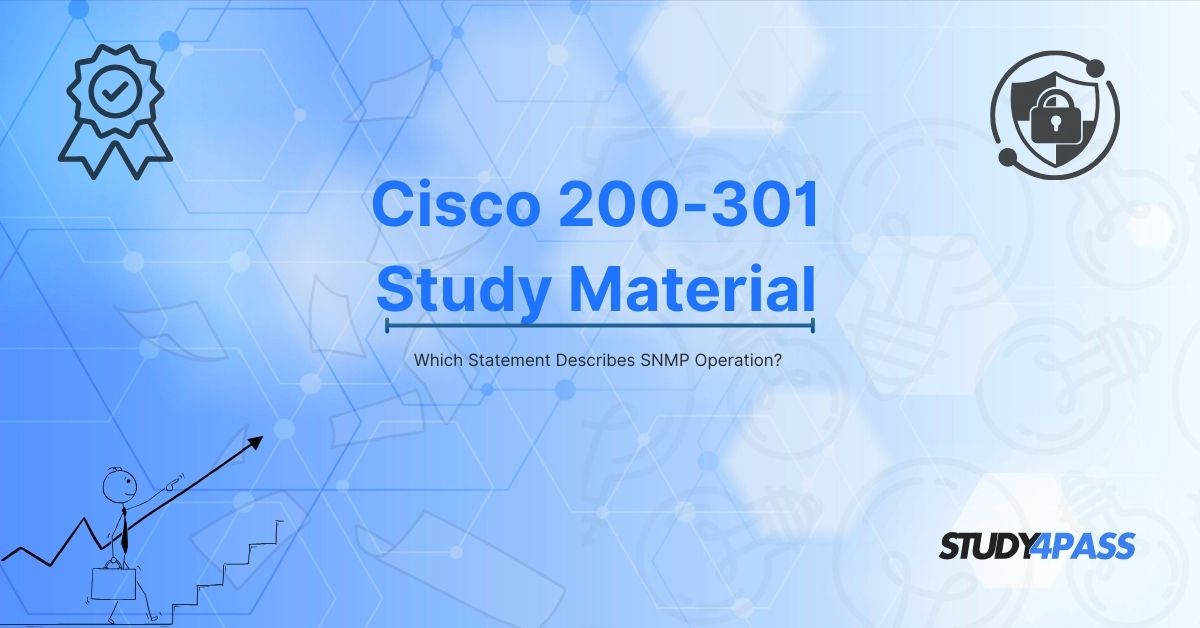Introduction to SNMP operation
Simple Network Management Protocol (SNMP) is a critical protocol used in network management and monitoring. It allows administrators to manage network performance, detect faults, and configure devices remotely. For students preparing for the CCNA 3 v7 Checkpoint Exam and the Cisco 200-301 certification, understanding SNMP operation is essential.
This article provides an in-depth explanation of SNMP operation, its components, and its role in network management. Additionally, we will discuss how Study4Pass can help you master SNMP concepts and other crucial topics for your Cisco certification exams.
What is SNMP?
SNMP is an application-layer protocol that facilitates the exchange of management information between network devices. It operates over UDP (port 161 for agents, port 162 for traps) and is widely used for monitoring routers, switches, servers, and other network-attached devices.
Key Components of SNMP
- SNMP Manager – The central system that monitors and controls SNMP-enabled devices.
- SNMP Agent – Software running on network devices that collects and sends data to the SNMP manager.
- Management Information Base (MIB) – A database that organizes device information in a hierarchical structure.
- SNMP Commands (PDUs – Protocol Data Units) – Used for communication between the manager and agent.
Which Statement Describes SNMP Operation?
To understand SNMP operation, let’s examine the following key statements:
-
SNMP Uses Get, Set, and Trap Operations
- Get Request: The manager retrieves data from an agent.
- Set Request: The manager modifies configurations on an agent.
- Trap: The agent sends unsolicited alerts to the manager about critical events.
SNMP Operates in Two Primary Modes: Polling and Interrupt-Based
- Polling: The manager periodically requests data from agents.
- Interrupt-Based (Traps/Informs): Agents notify the manager immediately when an event occurs.
SNMP Versions and Security Levels
- SNMPv1 & SNMPv2c: Use community strings (plaintext passwords).
- SNMPv3: Provides encryption, authentication, and access control for secure communication.
MIB Structure Defines Manageable Objects
- Each device has an OID (Object Identifier) that uniquely identifies manageable parameters.
These statements collectively describe how SNMP operates in real-world network environments.
SNMP in CCNA 3 v7 and Cisco 200-301 Exam
For the CCNA 3 v7 Checkpoint Exam and Cisco 200-301 certification, SNMP is a crucial topic. Here’s what you need to know:
Key Exam Topics Related to SNMP
- SNMP Components & Operations (Manager, Agent, MIB, Traps)
- SNMP Versions & Security (v1, v2c, v3 differences)
- Configuring SNMP on Cisco Devices
- Troubleshooting SNMP Issues
Understanding these concepts will help you answer exam questions effectively.
How Study4Pass Helps You Master SNMP and Cisco Certifications?
When preparing for the CCNA 3 v7 Checkpoint Exam or Cisco 200-301, having the right study resources is crucial. Study4Pass provides:
- Comprehensive Study Guides – Detailed explanations of SNMP operations, configurations, and troubleshooting.
- Practice Exams – Simulate real Cisco exam questions to test your knowledge.
- Hands-On Labs – Virtual labs to practice SNMP configurations on Cisco devices.
- Expert Tips & Tricks – Learn from industry professionals to ace your exam.
By using Study4Pass, you gain a structured learning path that ensures exam success.
Final Thoughts
SNMP is a fundamental protocol for network management, and mastering its operation is essential for the CCNA 3 v7 Checkpoint Exam and Cisco 200-301 certification. Understanding its components, versions, and security features will help you configure and troubleshoot networks efficiently.
For the best exam preparation, rely on Study4Pass for high-quality study materials, practice tests, and expert guidance. Start your journey to Cisco Certification success today with Study4Pass!
Special Discount: Offer Valid For Limited Time “Cisco 200-301 Exam Prep Practice Tests”
Actual exam question from Cisco's 200-301 Practice Test.
Sample Questions for Cisco 200-301 Test Prep
1. What is the primary function of SNMP?
A) Encrypting network traffic
B) Monitoring and managing network devices
C) Assigning IP addresses dynamically
D) Blocking unauthorized access to a network
2. Which SNMP component collects and stores management data?
A) SNMP Manager
B) SNMP Agent
C) MIB (Management Information Base)
D) Trap
3. What is the purpose of an SNMP Trap?
A) To request data from an agent
B) To send unsolicited alerts from an agent to a manager
C) To configure a network device remotely
D) To encrypt SNMP communications
4. Which SNMP version provides encryption and authentication?
A) SNMPv1
B) SNMPv2c
C) SNMPv3
D) SNMPv4
5. What does the SNMP "Get" command do?
A) Modifies a value on an agent
B) Requests data from an agent
C) Sends an alert to the manager
D) Deletes a MIB entry


